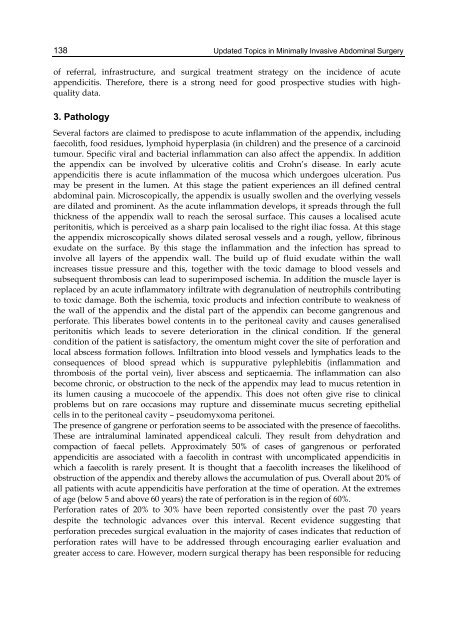UPDATED TOPICS IN MINIMALLY INVASIVE ABDOMINAL SURGERY
UPDATED TOPICS IN MINIMALLY INVASIVE ABDOMINAL SURGERY
UPDATED TOPICS IN MINIMALLY INVASIVE ABDOMINAL SURGERY
You also want an ePaper? Increase the reach of your titles
YUMPU automatically turns print PDFs into web optimized ePapers that Google loves.
138<br />
Updated Topics in Minimally Invasive Abdominal Surgery<br />
of referral, infrastructure, and surgical treatment strategy on the incidence of acute<br />
appendicitis. Therefore, there is a strong need for good prospective studies with highquality<br />
data.<br />
3. Pathology<br />
Several factors are claimed to predispose to acute inflammation of the appendix, including<br />
faecolith, food residues, lymphoid hyperplasia (in children) and the presence of a carcinoid<br />
tumour. Specific viral and bacterial inflammation can also affect the appendix. In addition<br />
the appendix can be involved by ulcerative colitis and Crohn’s disease. In early acute<br />
appendicitis there is acute inflammation of the mucosa which undergoes ulceration. Pus<br />
may be present in the lumen. At this stage the patient experiences an ill defined central<br />
abdominal pain. Microscopically, the appendix is usually swollen and the overlying vessels<br />
are dilated and prominent. As the acute inflammation develops, it spreads through the full<br />
thickness of the appendix wall to reach the serosal surface. This causes a localised acute<br />
peritonitis, which is perceived as a sharp pain localised to the right iliac fossa. At this stage<br />
the appendix microscopically shows dilated serosal vessels and a rough, yellow, fibrinous<br />
exudate on the surface. By this stage the inflammation and the infection has spread to<br />
involve all layers of the appendix wall. The build up of fluid exudate within the wall<br />
increases tissue pressure and this, together with the toxic damage to blood vessels and<br />
subsequent thrombosis can lead to superimposed ischemia. In addition the muscle layer is<br />
replaced by an acute inflammatory infiltrate with degranulation of neutrophils contributing<br />
to toxic damage. Both the ischemia, toxic products and infection contribute to weakness of<br />
the wall of the appendix and the distal part of the appendix can become gangrenous and<br />
perforate. This liberates bowel contents in to the peritoneal cavity and causes generalised<br />
peritonitis which leads to severe deterioration in the clinical condition. If the general<br />
condition of the patient is satisfactory, the omentum might cover the site of perforation and<br />
local abscess formation follows. Infiltration into blood vessels and lymphatics leads to the<br />
consequences of blood spread which is suppurative pylephlebitis (inflammation and<br />
thrombosis of the portal vein), liver abscess and septicaemia. The inflammation can also<br />
become chronic, or obstruction to the neck of the appendix may lead to mucus retention in<br />
its lumen causing a mucocoele of the appendix. This does not often give rise to clinical<br />
problems but on rare occasions may rupture and disseminate mucus secreting epithelial<br />
cells in to the peritoneal cavity – pseudomyxoma peritonei.<br />
The presence of gangrene or perforation seems to be associated with the presence of faecoliths.<br />
These are intraluminal laminated appendiceal calculi. They result from dehydration and<br />
compaction of faecal pellets. Approximately 50% of cases of gangrenous or perforated<br />
appendicitis are associated with a faecolith in contrast with uncomplicated appendicitis in<br />
which a faecolith is rarely present. It is thought that a faecolith increases the likelihood of<br />
obstruction of the appendix and thereby allows the accumulation of pus. Overall about 20% of<br />
all patients with acute appendicitis have perforation at the time of operation. At the extremes<br />
of age (below 5 and above 60 years) the rate of perforation is in the region of 60%.<br />
Perforation rates of 20% to 30% have been reported consistently over the past 70 years<br />
despite the technologic advances over this interval. Recent evidence suggesting that<br />
perforation precedes surgical evaluation in the majority of cases indicates that reduction of<br />
perforation rates will have to be addressed through encouraging earlier evaluation and<br />
greater access to care. However, modern surgical therapy has been responsible for reducing














![focuspdca.ppt [Compatibility Mode]](https://img.yumpu.com/22859457/1/190x146/focuspdcappt-compatibility-mode.jpg?quality=85)


